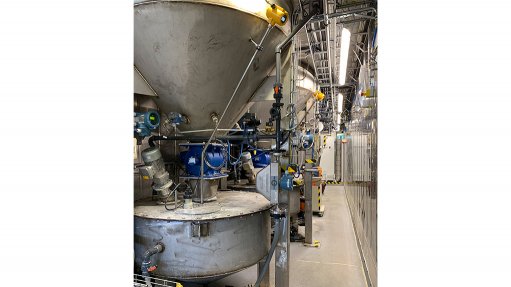
TESTING 1, 2 Lab-scale tests are constructed and the chemical recipe is adjusted
Following its attendance at the Investing in African Mining Indaba in February and, having previously conducted research on the country’s acid mine drainage (AMD) problem, Finland-based company EPSE is now involved in several mine water purification projects in South Africa.
“The mining industry is extremely conservative. While we are working on several projects, they have not attained full-scale launches yet, but are rather being conducted on a pilot basis,” EPSE international operations director Felix Fondem tells Mining Weekly.
EPSE’s understanding of AMD in South Africa has enabled it to create a water purification system using chemical treatment that effectively removes 99.99% of heavy metals.
“What started as a means of reducing costs on hazardous waste handling turned into a means of chemically cleaning insoluble matter from wastewater,” explains EPSE CEO Jouni Jääskeläinen.
The treatment involves the addition of the chemical and the adjustment of the pH to clean wastewater. However, the recipe of the chemical is altered depending on the composition of the AMD and the metal in the wastewater.
“Each mine’s wastewater, or more specifically, each metal, will have its own recipe that is optimised to break down the AMD and remove the metals almost entirely. This prevents metals from leaching out of the water and avoids potential environmental issues,” Fondem states.
Additionally, the EPSE system is a one-step system that could easily be used as either a standalone water purification system or a system that could be integrated into existing systems.
“In existing systems where there is a wastewater problem, mines can add the EPSE chemicals to the existing tanks, pools or ponds. Mines only need the chemical bonds and the mixers, which would raise the pH and purify the water. This makes the treatment extremely simple and avoids the need for hefty investments,” mentions Jääskeläinen.
Moreover, Fondem notes that the EPSE system can be added to enhance existing water purification systems.
“We are trying to market a system that will not require any major capital investment or necessitate the shutdown of existing water treatment plants, as this would be a very expensive procedure. We rather seek to upgrade existing systems with the addition of our chemical at the back- or front-end of the system or within the existing system.”
Fondem adds that it is “extremely important” to note that EPSE is able to adjust the chemical composition and let the main treatment system, work as intended.
Further, integrating the EPSE system into an existing system does not compromise the effectiveness of the EPSE system. “We construct lab-scale tests and adjust the chemical recipe accordingly to ensure that neither the EPSE system nor the existing system is compromised.”
As the primary focus of the EPSE system is metals and heavy metals in wastewater and AMD in mine wastewater, the system’s capabilities do not extend to municipal wastewater, which would primarily contain organic waste matter, concludes Fondem.